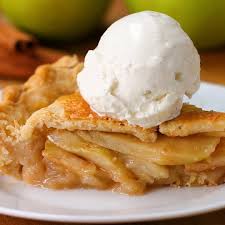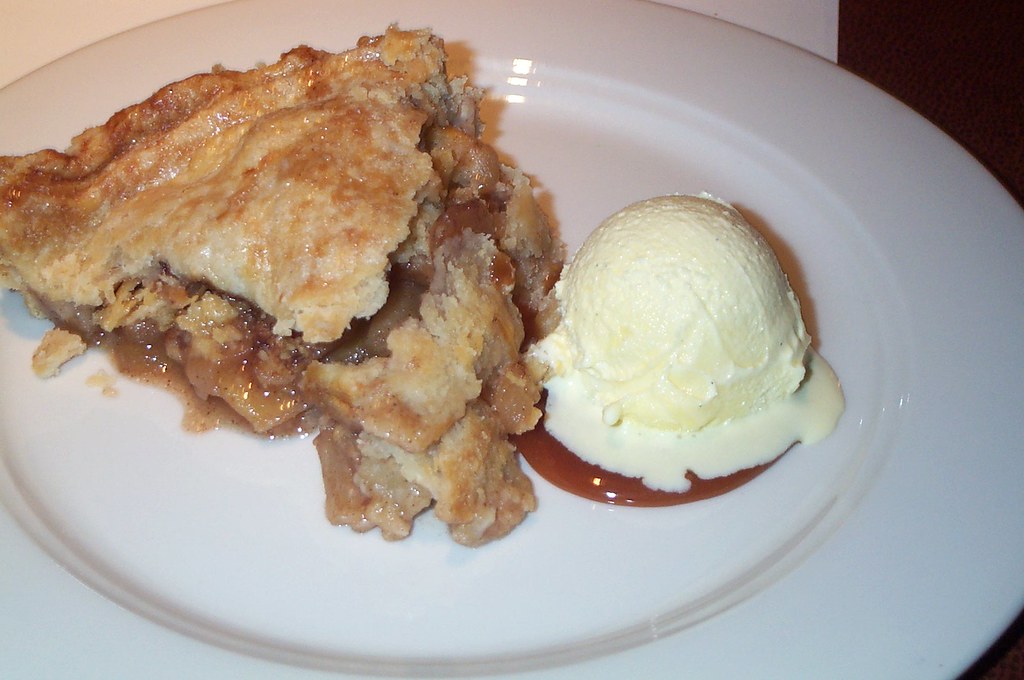Ahh…Mom and apple pie, as American as our flag.
Apple pie is a Fourth of July must-have, an enduring tradition, and super delicious with a scoop of vanilla ice cream.
If you asked a soldier in the Second World War what he was fighting for and what he missed the most, he would most likely have answered, “Mom and apple pie.” Together, these two classics conjure our coziest shared Americana, and in these challenging times, what could be more comforting than apple pie to bake and share?
My mom’s apple pie was a longtime staple in our Allentown, Pa., home, where you still can find ancient apple trees from forgotten orchards heavy with fruit when the summer drifts to fall. These apple trees, which dot the fields and woods of all around Allentown, have their own story to tell. None of them are any more native to the region than the notion of pie, and they invite an interesting question: How did apple pie come to be such an important part in our national and local mythology?
Well, things can be as American as apple pie, but, in a beautiful reflection of America’s melting pot, apple pie is not exclusively American.
Apple pie pops up in the food traditions of many cultures, and the first printed recipe, from England’s Geoffrey Chaucer, dates back to 1381.

In the Netherlands, you can find beautiful, deep, sweet cinnamon apple pies with a buttery, almost cake-like crust in any café. The first Dutch recipe dates to the 16th century, and apple pie first appears in Dutch art in the early 17th century. Usually packed with raisins, Dutch apple pie comes topped with heavy whipped cream, alongside a cup of strong black coffee to cut the sweetness perfectly.
This year, as we celebrate the 401 years from 1620 to 2021, it’s fun to remember that pie, too, came to New England aboard the Mayflower. The Pilgrims, having lived in both England and the Netherlands, arrived on local shores well steeped in pie tradition, but they must have been dismayed to find only the humble crabapple growing locally.
While apples had been grown in the colony of Jamestown a few years earlier for cider, the earliest known cultivated apples arrived in New England in 1623, probably aboard the supply ship Anne.
The early colonists got a lot of mileage from their apples. They made cider vinegar and apple cider, as well as hard cider, called AppleJack, which could double as an antiseptic. Along with honey, the apple added rare sweetness to the food of early new England, and finally, people could make apple pies.
There is perhaps nothing more comforting than the smell of a homemade apple pie in the oven, and perhaps no quicker way than sharing one to remind us of our connection to family and common tradition. If you do make an apple pie, make sure you plop a big scoop of vanilla ice cream on top for me.
My mom’s pie crust is quite a bit different than most. The following are some tips from my mom and I, to you.
Mom’s tips for pie dough success
This pie dough works a little differently than classic pie dough.
- Take the chill off the butter: With this recipe, you’ll work the butter into the flour with your hands, which will only work if the butter isn’t too cold. Take the butter out of the fridge and let it sit out for a few minutes in a warm spot before working it into the flour mixture.
- Squish the butter into the flour. As you work the butter into the flour pressing down with your knuckles in the bowl can help with this. Flattened pieces of butter will result in flaky layers.
- Stir the sour cream: Use full-fat sour cream and if it has separated in the container, stir it before adding it to the dough mixture.
- Make sure your dough disks do not have cracks in them: Don’t worry about overworking the dough; because of the way we incorporate fat, this is a very forgiving pie dough. As you work it into disks, it should end up smooth, having the consistency of Play-Doh.
- Once you wrap the dough disk in plastic wrap, you can massage the dough and the edges with your warm hands to close any cracks.
- Refrigerate dough for 2 hours.
Eva’s European Apple Pie
Sour Cream Pie Crust
Ingredients
- 2 cups all-purpose flour
- 1 teaspoon of salt (skip if using salted butter)
- 2 teaspoons of sugar (for sweet recipes, otherwise skip)
- 2 sticks unsalted butter (1 cup or 8 ounces) cubed
- 1/2 cup sour cream (full fat, sour cream)
Filling
Ingredients
- 6 cups peeled, thinly sliced Granny Smith apples (about 6-7 medium apples)
- 3/4 cup sugar
- 2 tablespoons all-purpose flour
- 1 tablespoon lemon juice
- 3/4 teaspoon cinnamon
- 1/4 teaspoon nutmeg
- 1/4 teaspoon salt
- 1 egg for egg wash, whisked
- Optional, but not really: serve with vanilla ice cream
Instructions
- Preheat oven to 425 degrees F.
- Unroll 1 pie crust disk and press it into 9” spring pan.
- In a large bowl, toss together all of the filling ingredients.
- Transfer filling to the spring pan.
- Unroll the second pie crust and place it on top of the apples.
- Tuck the extra top crust under the bottom crust edge, pinching together with your fingers to seal.
- Egg wash top dough.
- Cut slits in the top of the pie (to allow steam to vent).
- Bake for 40-45 minutes, or until apples are tender and crust is golden brown.
- About halfway through the baking time, cover the edge of the crust with strips of aluminum foil to prevent the edges from becoming too dark.
- Cool pie on a wire rack for at least 2 hours before slicing and serving.
Republished from San Diego Jewish World.


























